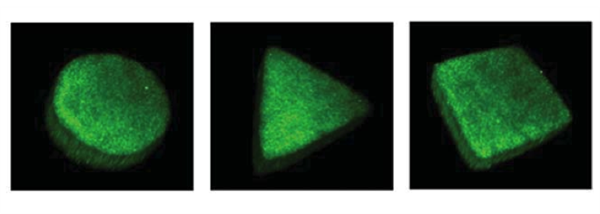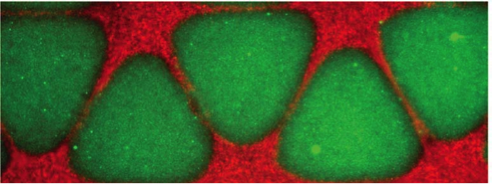Functional 3D Microtissues Within a Microfluidic Perfusion Device
Technology Description
UCSD researchers have formulated a method to fabricate three dimensional microtissues within a microfluidic device. This platform can be customized and used to study the response of cells and/or tissues to physical, electrical, chemical and mechanical changes in the micro-environment. It is anticipated that patient specific drug testing systems could be modeled by using biopsied cells.
Photolithographic methods are used to to pattern hydrogels with varying geometries so the special distribution can be controlled. The microfluidic device component allows perfusion and interaction with the cells supported by the microtissues. With this approach several cell types can be included within one chip. The chip can be used as a bioreactor to study various cell and tissue activities over time. The investigators are using this method to simulate a variety of diverse and complex organs and systems and to model disease progression, organ-organ interactions and as a platform to investigate cell-matrix interactions, cell signaling and cell-cell interactions.
The microfluidic device comprises the floor and ceiling, sandwiching the spatially confined microtissues with specific geometries and cell types to simulate in vivo organ systems. The hydrogels used are tunable, providing the ability to create on-chip sensors responsive to multiple parameters (temperature, pH, etc.). The incorporation of dynamic flow provides the capability to assess aspects important in real physiological conditions such as shear stress and pulsatile flow as well as serve as a delivery system to determine the effect of natural or synthetic molecules on a particular tissue or cell type.
Images of 3D Microtissues

Close-up of Vascularized Tissue Array

State Of Development
Working prototypes have been constructed for heart, skeletal muscle and liver and a tumor model. A provisional patent application has been filed.
Patent Status
| Country | Type | Number | Dated | Case |
| United States Of America | Published Application | 20180085750 | 03/29/2018 | 2015-211 |
| Patent Cooperation Treaty | Published Application | 2016164861 | 10/13/2016 | 2015-211 |
Contact
- University of California, San Diego Office of Innovation and Commercialization
- innovation@ucsd.edu
- tel: View Phone Number.
Other Information
Keywords
microfluidic, 3D, microtissue, hydrogel, platform, personalized medicine, drug testing, disease
